6.2.1 Type of rising mains
a. The type of rising main system provided shall be appropriate to the building as follows:
(1) dry rising mains shall be installed in PG II to VIII buildings of habitable height more than 10m, but not more than 60m;
E
Explanations & Illustrations
Clause 6.2.1a.(1) : Type of rising mains
.tmb-firecode.png?Culture=en&sfvrsn=42299b1c_1)
Figure 6.2.1a.(1) : Provision of dry rising mains
Dry rising main (dry riser).- A vertical pipe installed in a building for firefighting purposes, fitted with inlet connections at fire engine access level and landing valves on various floors, which is normally dry but is capable of being charged with water usually by pumping from fire engine pumps.
Dry rising mains are basically dry water pipes. The empty mains need to be charged with water through the breeching inlets by fire fighting appliance. The dry rising mains should not exceed 60m to avoid excessive pumping pressure.
Generally, building with a small foot print and the riser stack is located at the perimeter wall of the building, there is no need to provide landing valve at 1st storey level. However, if the riser stack is located deep inside the building as shown in Figure 6.2.1a.(1), then landing valve is required to be provided at 1st storey level.
(2) wet rising mains shall be installed in buildings with habitable height exceeding 60m; and
(3) separate dry and wet rising main systems in a building are permitted.
E
Explanations & Illustrations
Clause 6.2.1a.(3) : Type of rising mains
.tmb-firecode.png?Culture=en&sfvrsn=dde6da34_1)
Figure 6.2.1a.(3)
Where a block of residential building has podium and tower blocks integrated:
(1) Tower block exceeding 60m in habitable height shall be provided with wet rising main.
(2) Podium block needs to be provided with dry rising main only.
b. Notwithstanding the requirements in Cl.6.2.1a., dry rising mains conforming to SS 575 shall be provided to supply any part of a single
or multiple level basement.
E
Explanations & Illustrations
Clause 6.2.1b. : Type of rising mains

Figure 6.2.1b. - 1 : Rising mains in building of habitable ht. greater than 10m
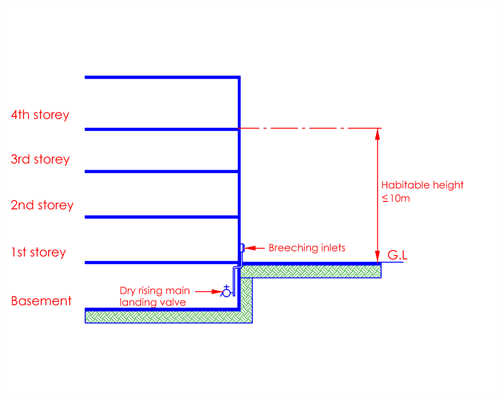
Figure 6.2.1b. - 2 : Rising mains in building of habitable ht. 10m and less
All basements except those under PG I are required to be covered by dry rising main, irrespective of the depth and number of basements below ground level. Rising main would help to provide steady supply of water required by firefighters during emergency. The provision would eliminate the tedious process of laying fire hoses from ground level into the basement floors to tackle any outbreak of fire.
Where breeching inlets are provided at the foot of the riser stack, landing valve for PG II is not required to be provided at the 1st storey level.
c. Where the building has access from more than one ground level or road level, the height measurements for the purpose of this Code shall be taken from the level of the fire engine accessway. Where there is no fire engine accessway, the height measurements shall be based on fire engine access road.
E
Explanations & Illustrations
Clause 6.2.1c. : Type of rising mains

Figure 6.2.1c. : Type of rising mains to be installed in high-rise buildings
1. For the purpose of determining the provision of rising main to an apartment or maisonette building, the habitable height shall be taken from the level of the lowest fire engine accessway or fire engine access road where breeching inlets are provided.
2. Dry rising mains are basically dry water pipes. The empty mains need to be charged with water through the breeching inlets by fire engines. The dry rising mains should not exceed 60m in height to avoid excessive pumping pressure.
3. Wet rising mains are constantly charged with water that provide the required flow rate and pressure for firefighting and equipped with water storage capacity for a given duration of 60 mins. The breeching inlets, usually provided at ground level, are meant for replenishing the water tank.
6.2.2 Number, location and size of rising mains
!
Note to QPs on Clause 6.2.2
Under normal circumstances, a building below 10m in habitable height would not require rising mains. However, if such buildings have very large floor area or footprint, whereby its internal areas are outside the coverage of a fire hose length of 38m from the fire-fighting access panels, it is recommended that the internal rising mains to be incorporated to cover these areas. Otherwise, consultation with the SCDF ought to be sought.
a. Standard
The number, distribution, size and installation of rising mains shall comply with the requirements stipulated in SS 575.
E
Explanations & Illustrations
Clause 6.2.2a. : Number, location & size of rising mains
.png?sfvrsn=3d572bc_4)
Figure 6.2.2a. - 1
All buildings with habitable height exceeding 10m would require one or more rising mains. All parts of the floor shall be within 38m from a landing valve.

Figure 6.2.2a. - 2
The provision of rising main shall be such that all parts of any floor are within 38m from a landing valve, measured along a route suitable for hose lines including any distance up or down a staircase.
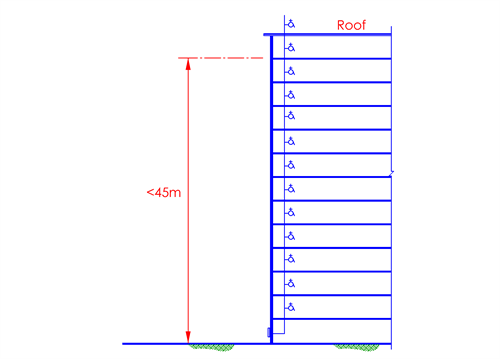
Figure 6.2.2a. - 3 : 100mm minimum nominal bore rising main
The minimum nominal bore of a rising main shall be 100mm where the rising main does not exceed 45m in height and only one landing valve is provided at each floor.

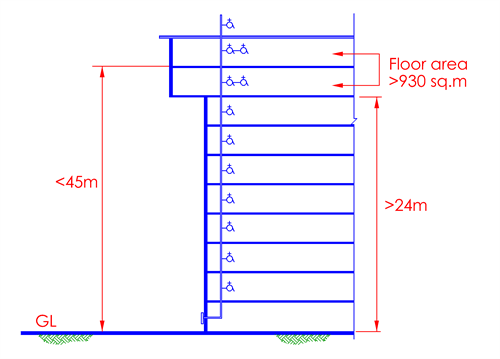
Figure 6.2.2a. - 4 : 150mm minimum nominal bore rising main
The minimum nominal bore of a rising main shall be 150mm where the rising main either (i) exceeds 45m in height or (ii) is permitted to have two landing valves on any floor.
The height of rising main is the habitable height measured from the fire engine access level to the finished floor level of the topmost floor served by the rising main, irrespective whether or not the main is extended above roof level. The above figure shows two landing valves being installed in the top 2 floors though the height of rising main does not exceed 45m, the minimum nominal bore of the rising main shall not be less than 150mm.
b. Locations of landing valves
Rising mains and the associated landing valves shall be kept free of physical and visual obstruction, and be located:
(1) within a fire lift lobby, smoke-free lobby or external corridor immediately outside the door of the exit staircase, or
E
Explanations & Illustrations
Clause 6.2.2b.(1) : Number, location & size of rising mains
-1.tmb-firecode.png?Culture=en&sfvrsn=f7e0ff0a_1)
Figure 6.2.2b.(1) - 1 Rising main in fire lift lobby/smoke-stop lobby
-2.tmb-firecode.png?Culture=en&sfvrsn=4f6d75ed_1)
Figure 6.2.2b.(1) - 2
Where rising mains is located within a protected lobby (smoke-free/fire lift lobbies), it need not be separately protected. However, if the rising mains is positioned or located within an unprotected areas/spaces, it shall be encased with a fire resistance enclosure.
-3.tmb-firecode.png?Culture=en&sfvrsn=bb36c5c7_1)
Figure 6.2.2b.(1) - 3
-4.tmb-firecode.png?Culture=en&sfvrsn=750a4959_1)
Figure 6.2.2b.(1) - 4
In the above situation (Figure 6.2.2b.(1) – 4) where the rising mains are located outside the staircases and along external exit passageway/external corridor which are naturally ventilated, there is no need to protect the rising main and landing valve separately, because the external exit passageway/external corridor is treated as ‘protected lobby’, for the purpose of interpretation and application of this requirement.
(2) in the case where there is no fire lift lobby, smoke-free lobby and external corridor, it shall be located inside an exit staircase, or in the common area and within a protected shaft, immediately outside the door of the exit staircase.
Note: Where there are provisions of fire lift lobby and smoke-free lobby within the building, the position of rising mains and landing valves shall first be located inside fire lift lobby.
E
Explanations & Illustrations
Clause 6.2.2b.(2) : Number, location & size of rising mains
-1.tmb-firecode.png?Culture=en&sfvrsn=6b88b6c7_1)
Figure 6.2.2b.(2) - 1 : Rising main outside protected staircase
-2.tmb-firecode.png?Culture=en&sfvrsn=c72f416c_1)
Figure 6.2.2b.(2) - 2 : Rising main inside protected staircase
The location of the rising main should not cause obstruction to the escape path inside the staircase.
c. Provision for landing valves and standby fire hoses
E
Explanations & Illustrations
Clause 6.2.2c. : Number, location & size of rising mains
1. Location of rising mains
The entire pipework and landing valves comprising each rising main system inside the building shall be confined:
a. within a ventilated lobby of a protected lobby approach stairway, where this is provided, or
b. in such other protected areas as may be agreed with the SCDF.
2. Rising mains shall be so located that they are protected against mechanical and fire damage.
3. No part of a rising main shall be placed in any shaft containing a gas, steam or fuel pipelines or electrical cables and wirings.
4. Where passing through other than protected area e.g. protected lobby shaft, pipe need to be encased or protected by and fire rating material with 2-hr fire resistance rating.

Figure 6.2.2c. - 1 : Example A - Block of flats/maisonettes
A single rising main is provided in example A as the distance from the remotest point in any residential unit to the rising main landing valve, measured along the route of travel, does not exceed 38m.

Figure 6.2.2c. - 2 : Example B
Two stacks of rising mains are required in example B if the coverage or travel distance to the remotest point of the floor exceeds 38m.

Figure 6.2.2c. - 3 : Example C : Office/factory/warehouse block
A single rising main is provided in example C as the distance from the remotest point in any unit to the rising main landing valve, measured along the route of travel, does not exceed 38m.

Not Acceptable
Figure 6.2.2c. - 4
The above figure shows rising main installed in the core of a building, meeting the requirements of distance coverage (38m). Such arrangement is deem not acceptable to the SCDF. The position of rising mains shall be located in the following areas (see Cl.6.2.2b.) in the order of priority.
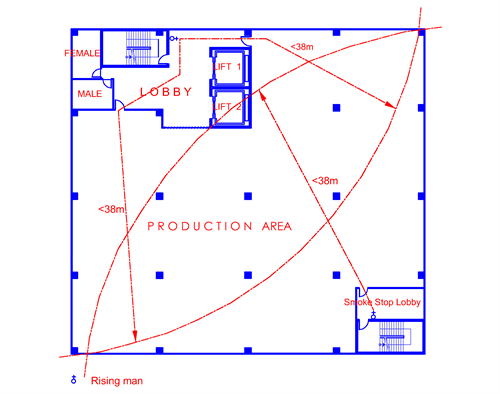
Acceptable
Figure 6.2.2c. - 5
The above figure is an acceptable arrangement of positioning rising mains in the order of priority. Two stacks of rising main are required if the distance exceeds 38m, measured from the landing valve to the remotest point.

Figure 6.2.2c. - 6
Where the pipe work and landing valve are located outside protected lobby or area allowed by the SCDF, they shall be protected by approved 2-hr fire-rated enclosures.
Provision of landing valve to any rising main for PG II at 1st storey is not required if any part of that storey is not more than 38m from the external wall of the building.
A landing valve with an instantaneous female coupling for connecting to SCDF’s 63.5mm diameter standard hose shall be provided for each rising main on every floor above the ground, including the 1st storey, every basement floor and on the roof for testing purposes. External walls refer to the external walls of the building that are facing or adjoining the boundaries. Where any part of the floor space in the building is less than 38m from the external wall, firefighters could connect multiple hose lengths to the fire pumper for the supply of water. As it is time consuming and laborious to connect additional multiple hose lengths, landing valve shall be provided to the rising mains at 1st storey if any part of the floor space in the building exceeds 38m from the external wall of the building.
(1) The location and provision for landing valves shall comply with SS 575. Where any part of the 1st storey of a building, except for PG II buildings, is more than 38m (30m hose line length and a jet throw of 8m) from the breeching inlet, a landing valve at the 1st storey shall be provided.
(2) Where all the exit staircases in a building under PG III to VIII are installed with rising mains and standby fire hoses, and yet part of a floor space is beyond the 38m (30m hose line length and a jet throw of 8m) coverage of any landing valve, an additional standby fire hose shall be provided at the landing valve nearest to this floor space.
6.2.3 Breeching inlets and fire engine accessways/ fire engine access roads
a. All buildings fitted with rising mains shall have a fire engine accessway/ fire engine access road for firefighting appliances within 18m of the breeching inlet. The breeching inlets shall be visible from the fire engine accessway/ fire engine access road.
E
Explanations & Illustrations
Clause 6.2.3a. : Breeching inlets & fire engine accessway/
fire engine access road
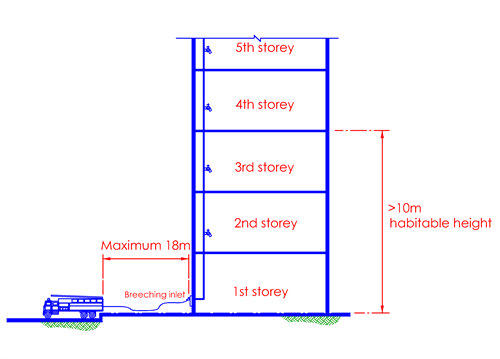
Figure 6.2.3a.
(a) The breeching inlets would be located on the external wall of the building and to be within 18m of the fire engine accessway or fire engine access road. The breeching inlets shall be visible from the adjacent accessway.
(b) Thus, a fire engine accessway can serve more than one rising main to one or more buildings, provided (a) above is complied with.
b. The requirements and provisions for breeching inlets for the rising main system shall be in accordance with the SS 575. Connecting pipes between the inlets and the vertical run of the rising mains, where applicable, shall be kept as short as possible.
E
Explanations & Illustrations
Clause 6.2.3b. : Breeching inlets & fire engine accessway/
fire engine access road
( No illustration )
The inlets and the vertical run of the rising main shall be kept as short as possible. The total pressure loss of the dry rising main shall not exceed 6 bar based on the design water flow rate. This is to correspond with the maximum habitable height of 60m.
a. Water supply
The capacity of the water supply from the public mains and the storage capacity for a wet rising main system shall comply with the requirements in SS 575.
E
Explanations & Illustrations
Clause 6.2.4a. : Wet rising mains
( No illustration )
1. For wet rising mains it is essential that pressures and flows be adequate at all times to serve the required number of jets likely to be used.
2. The water supply to the rising mains should be kept entirely independent of water supplies feeding other installations including those for other firefighting systems.
3. Means of supply for wet rising mains
a. Each wet rising main shall be fed from a suction or storage tank having a minimum effective storage capacity capable of supplying water at the rate of 27 L/s for a period of at least 30 minutes.
b. The storage tank(s) shall be automatically supplied either directly or indirectly via other tanks from a public main(s). The pipe drawing water from public mains to the tank shall be at least 150mm in diameter.
c. Break tanks not serving as storage tanks shall have an effective holding capacity of not less than 11.5m³ for each wet rising main.
4. Water tanks for wet rising mains
Tanks supplying water for domestic purposes shall not be used as suction tanks for wet rising mains.
b. Flow
The flow requirements for wet rising main system shall comply with those stipulated in SS 575.
E
Explanations & Illustrations
Clause 6.2.4b. : Wet rising mains
1. The minimum water supply flow rate shall be maintained in the wet rising system when 3 landing valves within the system are in the fully open position:
a. 27 L/s for a residential building.
b. 38 L/s for a non-residential and mixed occupancy building.
2. When more than one wet rising main is required in any zone in a building, the minimum common water supply shall be as stated below. Where the total maximum supply rate exceeds those stated in (a) and (b), another common water supply system shall be used.
a. For a residential building, 27 L/s for each rising main.
b. For a non-residential or any mixed occupancy building 38 L/s for the first rising main and 19 L/s for each additional rising main, subject to a total maximum supply rate of 95 L/s for PG III, IV, V & VII buildings and 133 L/s for PG VI and VIII buildings.
c. Running pressure
Running pressure at each discharging landing valve on the wet rising main system shall be maintained between the minimum and maximum values as stipulated in SS 575.
E
Explanations & Illustrations
Clause 6.2.4c. : Wet rising mains
( No illustration )
A minimum running pressure of 3.5 bar and a maximum of 5.5 bar shall be maintained at each landing valve when any number, up to three, are fully opened.
d. Static pressure
Static pressure in any line of hose connected to a landing valve in a wet rising main system shall not exceed the specified value in SS 575.
E
Explanations & Illustrations
Clause 6.2.4d. : Wet rising mains
( No illustration )
1. To reduce the risk of hose bursting, arrangements shall be made in accordance with BS 5041: Pt 1 so that when the water is shut off at the nozzle the static pressure in any line of hose connected to a landing valve does not exceed 8 bar.
2. To dispose of excess flows and pressures over and above those required (i.e. when only one jet is in use) a pressure control valve shall be incorporated in the body of the landing valve which is then permanently connected into the relief pipe. This relief pipe should run throughout the length of the wet rising main installation and should terminate either back into the suction tank or to drain.
e. Storage tanks
The location of storage tank and capacity of break tank where required shall comply with the requirements in SS 575.
E
Explanations & Illustrations
Clause 6.2.4e. : Wet rising mains

Figure 6.2.4e. - 1 : Wet rising mains system for building height exceeding 60m
1. The location and number of storage tank would be determined by the design of the wet rising main system and the height of the building. SS 575 should be fully complied with.
2. It is important that at early design stage of the building, the type of design of the wet rising main system should be drawn up to allow allocation of space for pumps and water tanks.
3. Usually, storage tanks and pumps are located in mechanical service floor in upper storey and basement, and on the roof of the building.
4. The capacity of break tank shall have an effective holding capacity of not less than 11.5m³ for each wet rising main.
Footnote:
(a) Storage tank is water tank having a minimum effective wet rising main storage capacity capable of supplying water at a given rate for a period of at least 30 minutes.
(b) Break tank is either (a) a tank into which the incoming supply connection from the PUB water mains discharge, or (b) an intermediate tank for limiting the system pressure.
(c) Suction tank is a tank from which a pump can draw water.

Figure 6.2.4e. - 2 : Fire hose cabinet detail
Wet rising mains system
1. “Wet rising mains” function similarly to dry rising mains. However, the pipes are permanently charged with water from a pressurised supply, and fitted with landing valves on various floors.
2. The breeching inlet act as an alternative means of supplying water to the rising mains system should the incoming public water supply pipes be damaged or the water supply is inadequate.
f. Fire pumps
Installation of fire pumps for wet rising main system shall comply with the requirements of SS 575. Wet riser pumps shall be installed within a fire compartmented fire pump room, whose fire rating shall be in accordance with Table 6.4A. The fire pump room floor level shall not be lower than the main floor level.
E
Explanations & Illustrations
Clause 6.2.4f. : Wet rising mains

Figure 6.2.4f. : Example of pump room in basement
Pump room in basement
1. Pumps, which are part of the wet rising main system, must be properly protected from the effect of heat and fire. As pumps are the vital nerves of the system, they should be installed in room having the necessary fire-rated enclosures and door (min 2-hr fire resistance rating).
2. Pumps shall be selected to meet the design requirements of the rising main system and be listed by recognised institution such as UL or FM.
3. There should be a voice communication system to provide intercommunication amongst all pump rooms.
4. Mechanical ventilation and electrical lighting in the pump room shall be equipped with standby emergency power supply.
g. Water supply system
(1) The water supply requirements for wet riser system shall be as follows:
| TABLE 6.2.4g: WATER RISER SYSTEM
|
|---|
| No: of stacks
| Water flow rate (L/s)
|
|---|
| Non-residential buildings
| Residential buildings
|
|---|
| 1 | 38
| 27
|
| 2
| 57
| 40.5
|
| 3
| 76
| 54
|
| 4 & above
| 95
| 67.5
|
(2) The minimum water storage capacity shall be capable of supplying water at the above flow rate for the period as specified in SS 575.
6.2.5 Standby fire hose for rising mains
Standby fire hoses shall be provided for every rising main except for those in buildings under PG II. The following requirements shall be complied with:
a. Type and folding method
E
Explanations & Illustrations
Clause 6.2.5a. : Standby fire hose for rising mains
Standby hose provides the firefighter greater hose length connection in situation where the floor space is extensive. The hose from other floors could be transferred to fire floor quickly when required by firefighters. Standby hose shall be kept locked in a cabinet, when placed along escape corridor, in common area and circulation space. The hose is allowed to be left mounted on hook or cradle inside the riser main shaft.
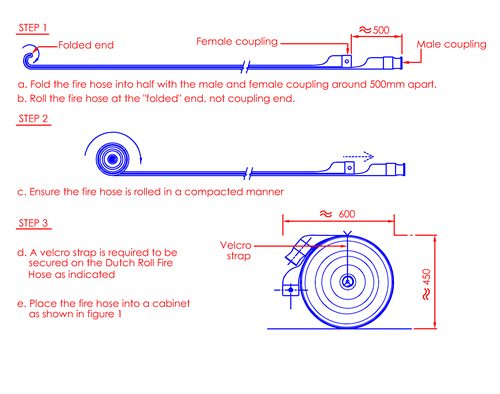
Figure 6.2.5a. : Dutch roll folding method
(1) The standby fire hose shall be of 63.5mm nominal internal diameter in order to ensure that the hose coupling will fit the existing coupling tail pieces. The hose shall be rugged and capable of carrying water under substantive pressure in accordance
with BS 6391. The fire hose shall be of Type 3 as stipulated in BS 6391.
(2) The fire hose couplings shall be manufactured to BS specifications or equivalent and of be light alloy or gunmetal. The coupling shall be of 63.5mm diameter and be of the instantaneous type with standard (double-pull) release mechanism. The couplings
shall be secured to the hoses with galvanised mild steel wire and applied over a hose guard of synthetic fibre. It shall be able to withstand a minimum working pressure of 15 bars.
(3) Each hose shall have a standard length of 30m and shall be kept stowed in a Dutch Roll and housed in a glass fronted cabinet. The Dutch Roll shall be rolled in the manner shown in Diagram 6.2.5a.(3).
b. Position
E
Explanations & Illustrations
Clause 6.2.5b. : Standby fire hose for rising mains
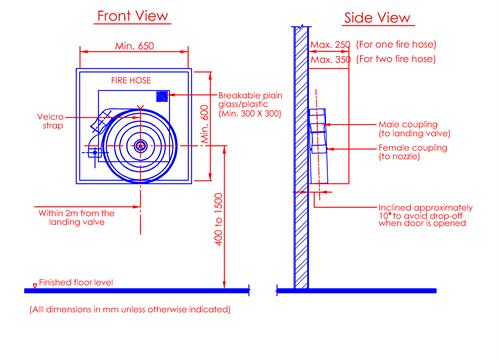
Figure 6.2.5b. : Dutch rolled fire hose with cabinet (surface-mounted or recessed)
(1) The fire hose shall be installed just next to, but not more than 2m from the landing valve as shown in Diagram 6.2.5b.(1).
(2) The entire fire hose and cabinet shall be installed away from direct sunlight.
c. Mounting
The wall mounted fire hose and cabinet shall be as follows:
(1) The cabinet shall be firmly mounted on the wall and able to withstand the weight of the hose(s) it houses.
(2) The cabinet shall be constructed of non-combustible material and be maintenance free.
(3) The cabinet lock, if provided, shall be one that can be operated manually from the inside without the use of a key when the front tempered glass (minimum 300mm x 300mm) is broken by firefighters.
(4) The cabinet swing door shall be made openable such that it will not obstruct the retrieving of the fire hose by firefighters.
(5) The depth of the cabinet shall not exceed 250mm for one fire hose or 350mm for two fire hoses.
(6) The cabinet shall be painted in a contrasting colour such that it is conspicuous and easily identified.
(7) The wording, “FIRE HOSE”, with letter height of at least 50mm and shown in contrasting colour, shall be painted directly on the front panel as shown in Diagram 6.2.5b.(1).
(8) In lieu of the cabinet, a simple wall mounted cradle for the fire hose can be provided, but only in the riser main shaft. The cradle shall be constructed and positioned to facilitate the retrieving of fire hose by firefighters.
(9) The cradle (in lieu of the cabinet) shall be maintenance-free. The fire hose installation height shall be limited as indicated in Diagram 6.2.5b.(1).
d. General
(1) Only clean, dry and compactly rolled (Dutch Roll with the Velcro strap secured as shown in the Diagram 6.2.5a.(3) and
b.(1)) hose(s) shall be placed in the cabinet.
(2) BS 6391 stipulates the technical requirements for quality acceptance standards of the fire hose. In addition, the above mentioned requirements shall be applicable for acceptance of the standby fire hose.
!
Note to QPs on Clause 6.2.5d
QPs are reminded to ensure that premise owners are aware of the manufacturer's recommendation for maintenance of the standby hoses provided on site.
6.2.6 Building under construction
Effective Date: 1 Sep 2021
E
Explanations & Illustrations
Clause 6.2.6 : Building under construction
Provision of wet rising main is required when building exceeds a habitable height of 60m.

Figure 6.2.6 - 1 : Under-construction building of habitable ht not exceeding 60m
Rising main is dry type before the habitable height of 60m is reached.

Figure 6.2.6 - 2 : Under-construction building of habitable ht exceeding 60m
Rising main is converted to wet type with the installation of pump and water tank
a. Breeching inlets
Breeching inlets (2-way or 4-way) should be provided as per approved building plan.
b. Fire lift
As it is not feasible to provide fire lift for use by firefighters, a passenger hoist, which is usually installed at site could be used. The hoist need not serve the topmost 3 floors, until the roof is being completed.
c. Electrical power supply
Supply from power grid or generator set could be acceptable.
d. Fire engine access road
During construction stage, there could be other works involving laying of services, excavation work etc that would prevent provision of access road and the space available would not permit the maneuverability of fire engine.
However, every opportunity should be taken to put in the access road in place. This is necessary for the purpose of conducting effective fire fighting operations should a fire occur at any time. In view of the above, additional portable fire extinguishers should be provided at each floor level instead.
e. Rising main landing valve
Rising main and landing valve shall be provided to every floor, except the topmost 3 floors as the building gains height, and made operational.
f. Rising main pressure & flow
As it is not feasible to provide a full-sized water tank and pump to meet the flow and pressure required for 45 mins of firefighting, a break tank of minimum 11.5m³ should be provided, instead for firefighting of 5 mins duration. Upon the arrival of fire engine the tank could be replenished via the public hydrant. The break tank must be constructed before the building reaches the 60m height.
g. Responsibility/Accountability
The main contractor for the project shall be responsible and accountable for the provision and maintenance of the rising main in the building under construction.
h. Checklist
Inspection and testing checklists of rising mains are attached for ease of reference.
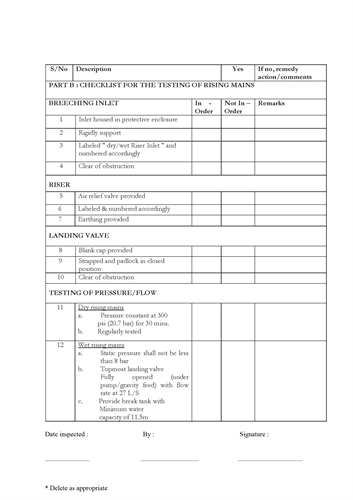

Amendment History
| 6.2.6 |
1 Sep 2021 |
1 Sep 2021 |
Clarification |
Building under construction When a building in pursuance of Cl.6.2.1, is required to be equipped with rising mains, such rising mains shall be installed progressively as the building attains height during the course of construction. All outlets, landing valves and inlets, water tanks and pumps, and hydrants shall be properly installed so as to be readily operational in case of fire. |
1 Sep 2021 |
Download
|
When a building in pursuance of Cl.6.2.1, is required to be equipped with rising mains, such rising mains shall be installed
progressively as the building attains height during the course of construction. All outlets, landing valves and inlets, water tanks and pumps, and hydrants shall be properly installed so as to be readily operational in case of fire.
Amendment History
| 6.2.6 |
1 Sep 2021 |
1 Sep 2021 |
Clarification |
Building under construction When a building in pursuance of Cl.6.2.1, is required to be equipped with rising mains, such rising mains shall be installed progressively as the building attains height during the course of construction. All outlets, landing valves and inlets, water tanks and pumps, and hydrants shall be properly installed so as to be readily operational in case of fire. |
1 Sep 2021 |
Download
|
6.2.7 Foam inlets
E
Explanations & Illustrations
Clause 6.2.7 : Foam inlets

Figure 6.2.7
The above figure shows the foam supply pipe being run through a room adjoining the boiler room. The other alternative of routing the pipe works through the boiler room is acceptable if the pipes are enclosed with fire-rated materials having the necessary fire resistance rating.
Foam inlets pipe works are provided for the purpose of delivering foam solution to the lobby or circulation area close to the room(s) containing highly combustible materials. This arrangement is similar to a rising main system, except that it is meant to deliver foam solution instead of water. Under this arrangement, ready mixed foam solution would be pumped into the 2-way breeching inlets at ground level. Firefighter would carry the necessary hoses with foam making branch to tap the foam solution from the landing valve and to jet in the foam at the seat of the fire in the room.
a. Provision
(1) Where boiler room or storage room containing highly combustible materials are located in a basement, or is not easily accessible for firefighting, foam inlets and pipe works shall be provided for the purpose of delivering foam solution to an area close to the room concerned.
(2) In situations where such rooms have access openings along a fire engine
accessway, provision of foam solution inlets and outlets is not required.
b. Breeching inlet
A two-way breeching inlet shall be provided at ground level with pipe run of minimum 100mm bore, terminating with a landing valve just outside the high fire risk room. The provision of the breeching inlet shall comply with the relevant clauses of SS 575.
6.2.8 Hose reels
Effective Date: 1 Sep 2021
Amendment History
| 6.2.8 |
1 Mar 2021 |
1 Sep 2021 |
Revised/Clarification |
Hose reels a. Provision (1) Hydraulic hose reel(s) conforming to the requirements in SS 575 shall be provided to every storey of every building regardless of building height. (2) Where a roof level is a non-habitable floor, fire hose reels shall be provided to cover the M&E plants/equipment. (3) Exemption (a) PG I buildings. (b) Non-residential occupancy at the 1st storey of a mixed commercial-cum-residential building or single storey standalone building and fulfilling all of the following conditions: (i) AFA of the non-residential unit does not exceed 150m². (ii) Individually compartmented, except for the parts of the unit fronting and within 3m from the external. (iii) Not being used as an eating establishment, or for storage of flammable materials. (iv) Not being used as a public entertainment outlet. (v) Not belonging to PG VI or VIII buildings. (vi) Not being used as a dormitory, hostel, etc. where sleeping risk is involved. (c) Other standalone buildings as follows: (i) Single-storey guard houses. (ii) Bin centres. (iii) 22kV (and lower) electrical substations. (iv) Open-sided sheds (excluding those for PG VI and VIII usages) with floor areas not exceeding 200m2 and openings that constitute not less than 80% of the perimeter wall area (measured along the roof eaves). |
1 Mar 2021 |
Download
|
a. Provision
(1) Hydraulic hose reel(s) conforming to the requirements in SS 575 shall be provided for every storey of every building regardless of building height.
Amendment History
| 6.2.8 |
1 Mar 2021 |
1 Sep 2021 |
Revised/Clarification |
Hose reels a. Provision (1) Hydraulic hose reel(s) conforming to the requirements in SS 575 shall be provided to every storey of every building regardless of building height. (2) Where a roof level is a non-habitable floor, fire hose reels shall be provided to cover the M&E plants/equipment. (3) Exemption (a) PG I buildings. (b) Non-residential occupancy at the 1st storey of a mixed commercial-cum-residential building or single storey standalone building and fulfilling all of the following conditions: (i) AFA of the non-residential unit does not exceed 150m². (ii) Individually compartmented, except for the parts of the unit fronting and within 3m from the external. (iii) Not being used as an eating establishment, or for storage of flammable materials. (iv) Not being used as a public entertainment outlet. (v) Not belonging to PG VI or VIII buildings. (vi) Not being used as a dormitory, hostel, etc. where sleeping risk is involved. (c) Other standalone buildings as follows: (i) Single-storey guard houses. (ii) Bin centres. (iii) 22kV (and lower) electrical substations. (iv) Open-sided sheds (excluding those for PG VI and VIII usages) with floor areas not exceeding 200m2 and openings that constitute not less than 80% of the perimeter wall area (measured along the roof eaves). |
1 Mar 2021 |
Download
|
(2) Where a roof level is a non-habitable floor, fire hose reels shall be provided to cover the M&E plants/ equipment.
(3) Exemption
(a) PG I buildings.
(b) Non-residential occupancy at the 1st storey of a mixed commercial-cum-residential building or single storey standalone building, which fulfils all of the following conditions:
(i) AFA of the non-residential unit does not exceed 150m².
(ii) Individually compartmented except for the parts of the unit fronting and within 3m from the external space.
(iii) Not used as an eating establishment, or for storage of flammable materials.
(iv) Not used as a public entertainment outlet.
(v) Not belonging to PG VI or VIII buildings.
E
Explanations & Illustrations
Clause 6.2.8a.(3)(b) : Hose reels
(b).tmb-firecode.png?Culture=en&sfvrsn=75cef17_1)
Figure 6.2.8a.(3)(b)
The staircase serving the upper storey living quarters shall be compartmented from the shop area by minimum 1-hr fire-rated enclosures. The communicating side access door between the staircase and shop area at 1st storey level shall be minimum ½-hr fire-rated and fitted with self-closer. This door shall always be kept in the closed position to prevent smoke and fire from spreading to the living quarters if there is a fire in the shop area.
(vi) Not used as a dormitory, hostel, etc. where sleeping risk is involved.
Effective Date: 01 Mar 2019
Amendment History
| 6.2.8a.(3)(b)(vi) |
|
01 Mar 2019 |
New |
|
--- |
-
|
(c) Other standalone buildings as follows:
(i) Single-storey guard houses.
(ii) Bin centres.
(iii) 22kV (and lower) electrical substations.
(iv) Open-sided sheds (excluding those for PG VI and VIII usages) with AFA not exceeding 200m2 and openings that constitute not less than 80% of the perimeter wall area (measured along the roof eaves).
(v) Domestic water supply, rainwater, wastewater, sewage pumping stations with AFA not exceeding 300m2.
(vi) Roof level of single storey buildings with roof height not more than 12m or inaccessible pitched roof up to 24m from grade level used solely for roof-mounted PV installations in accordance with Cl.10.2.1b.(1).
(vii) Roof level of an external/ open-sided overhead bridge/ shed/ linkway/ walkway with clear width less than 6m, roof height not more than 12m and used solely for roof-mounted PV installations in accordance with Cl.10.2.1b.(1).
(d) Mezzanine floor of factory unit, subject to compliance with Cl.9.6.1a.(2), and provided the coverage distance
of the nearest hose reel at the main floor to the most remote point of the mezzanine floor does not exceed 36m (30m hose path and 6m throw).
E
Explanations & Illustrations
Clause 6.2.8a.(3)(d) : Hose reels
Small buildings refer to detached and standalone buildings, such as guardhouse, pump house, bin centre, electrical substation. These would not be required to be provided with hydraulic hose reel. However, suitable type of fire extinguisher should be provided instead. For other types of small building, QPs should consult the SCDF before making building plan submission.
(d).tmb-firecode.png?Culture=en&sfvrsn=bbb76c66_1)
Figure 6.2.8a.(3)(d)
*Distance is to be measured along a route suitable for the hoseline having regard to any obstruction.
b. Size and type
The hose shall be of 20mm or 25mm nominal diameter and conform to EN 694, shall not exceed 30m in length and terminate in “shut-off” branches with 4mm or 6mm nozzles.
E
Explanations & Illustrations
Clause 6.2.8b. : Hose reels
( No illustration )
1. The reel or drum should be of adequate size to wind up the 30m length hose.
2. The length of the hose should not exceed 30m. The main reasons are:
(a) an occupant using the hose reel to fight an incipient fire need not traverse more than 30m. Consideration must be given that the occupant needs to retrace his path to a safe exit if the incipient fire could not be put out. Thus, the aggregate travel distance to and from the incipient fire should not be excessive;
(b) longer than 30m hose would require a bigger reel which would create some difficulties in running out the hose and that jamming of tubing could occur when in use.
3. An operating instruction notice plate should be provided next to the stop valve. The hose reel operating instructions shall be:
“Turn on the inlet valve before running out the hose”
4. All hose reels should be tested at least once a year. The test is to ensure that they are maintained in working order and able produce a jet of water with a minimum of 6m throw.
5. Hose reels located in recesses or cabinets shall bear the appropriate sign in accordance with SS 508
6. Hose reels are now required to be type tested by a recognised testing laboratory to meet the standard of EN 671 – 1 or equivalent and are subject to the Productivity & Standards Board Inspection Scheme.
c. Water supply
Water supply for hose reels in terms of flow rate and minimum running pressure shall comply with the requirements in SS 575.
E
Explanations & Illustrations
Clause 6.2.8c. : Hose reels

Figure 6.2.8c.
EXTRACTS FROM SS 575
1. Minimum requirements
(a) As a minimum, the water supply to hose reels shall be such that when the two topmost hose reels with the least hydraulic head in a building are operating simultaneously, each will provide a jet of at least 6m in length at a flow rate of at least 0.4 L/s. For example, when a 30m length of hose reel tubing (Type A of BS 3169) is in use with a 6.5mm nozzle, a minimum running pressure of 1.5 bar will be required at the entry to each reel. Similarly, for a 4.5mm nozzle, a minimum running pressure of 4 bars will be required.
(b) Pipework shall not be less than 50mm nominal bore and feeds to individual hose reels shall be at least 25mm nominal bore.
2. Hose reel pump
(a) Where the water pressure in hose reel main needs to be boosted, the provision of an electrically driven pump is usually a convenient method. A duplicate standby pump shall also be provided.
(b) Both motors and pumps shall be sited in positions where they are protected against tampering and physical and fire damage and the electrical supply to them shall be by an exclusive circuit with the cables following a route of negligible fire risk or be provided with adequate protection.
(c) The hose reel pumps system shall come into operation automatically with a drop in pressure or a flow of water. Both pumps shall be automatically primed at all times.
(d) All pumps shall also be capable of being started or stopped manually. The standby pump shall be so arranged that it will operate automatically on failure of the duty pump. Where more than one source of electrical supply is available, the duty and standby pump shall be connected to the different sources.
(e) Connection for boosted supplies - pumps shall be fed from a suction tank or inter-connected tanks having a minimum capacity of 1100 L. The tanks shall be automatically supplied from a town main or a reliable source, controlled by a ball valve of minimum diameter 50mm.
(f) Use of domestic water tank - tanks supplying water for domestic purposes shall not be used as suctions for hose reel installations unless arrangements have been made for domestic supplies to be drawn off in such a manner that the requisite reserve of water for the hose reel installation is always preserved.
3. Connection for boosted supplies
Pumps shall be fed from a suction tank or inter-connected tanks having a min. capacity of 1100 L. The tank(s) shall be automatically supplied from a town main or a reliable source, controlled by a ball valve of minimum diameter 50mm.
4. Use of Domestic Water Tanks
Tanks supplying water for domestic purposes shall not be used as suctions for hose reel installations unless arrangements have been made for domestic supplies to be drawn off in such a manner that the requisite reserve of water for the hose reel installation is always preserved. There shall not be any risk of contamination of water due to stagnation in the tank. The design of such arrangement is subject to PUB’s approval.
Footnote: Hose reel and sprinkler systems can share the same water tank under the conditions stipulated in SS CP 52.
d. Siting and installation
(1) Siting and details of installation for hose reels shall comply with the requirements in SS 575.
E
Explanations & Illustrations
Clause 6.2.8d.(1) : Hose reels
-1.tmb-firecode.png?Culture=en&sfvrsn=4095339_1)
Not Acceptable
Figure 6.2.8d.(1) - 1
The distribution of hydraulic hose reels as shown above is not acceptable as there is a pocket of area that is beyond the coverage of the hose reels.
-2.tmb-firecode.png?Culture=en&sfvrsn=8fa9df5e_1)
Not Acceptable
Figure 6.2.8d.(1) - 2
EXTRACT FROM SS 575
Distribution of hydraulic hose reel
1. Siting
a. Hose reels shall be sited in prominent and accessible positions adjacent to exits, preferably just outside protected corridors, lobbies or staircases on exit routes, but not inside staircases.
b. In planning the location of hose reels, consideration should be given to the following points:
(1) Access to hose reels should not be obstructed by the parking, loading and unloading of vehicles or by the location of furniture, equipment or other material.
(2) Protection of hose reels from mechanical damage and unauthorised use.
(3) The location of internal walls, partitions, doorways, storage racking, stored heights of goods and other obstructions, which could restrict normal hose coverage through the building.
2. Installation of hose reels
References shall be made to SS 575 for details on installation of the hose reel.
(2) Hose reels shall be sited in prominent and accessible locations within a distance of 5m from the exit door but not inside exit staircases. If there are parts of the floor space that are beyond the 36m coverage (30m hose path and 6m throw) of the hose reel, additional hose reels shall be provided at the common area or at a distance of not more than 5m from the exit access door of a room.
(3) Hose reels located within a room shall not be used for covering the areas outside the room.
Effective Date: 01 Mar 2019
Amendment History
| 6.2.8d.(3) and (4) |
|
01 Mar 2019 |
New |
|
--- |
-
|
e. Piping
The use of copper or stainless steel piping is permissible for the connection of the hose reels to the PUB mains
E
Explanations & Illustrations
Clause 6.2.8e. : Hose reels
( No illustration )
1. Pipework for hose reel system shall not be less than 50mm nominal bore and feeds to individual hose reels shall be at least 25mm nominal bore.
2. Copper or stainless steel pipes can be incorporated in the pipe works supplying water to the hose reels.
The above sub-clause allows the flexibility of using alternative material for the water supply pipe of the hose reel system.
6.2.9 Graphical symbols
E
Explanations & Illustrations
Clause 6.2.9 : Graphical symbols

Figure 6.2.9
The minimum size of the symbol when viewed more than 12m away. The size of symbol is not inclusive of borders.
Graphical symbols to depict fire safety equipment are allowed for use in buildings provided the signs comply with SS 508. The Table 6.2.9 shows the different sizes of the graphical symbol with respect to the viewing distance.
| TABLE 6.2.9 SIZES OF GRAPHICAL SYMBOLS
|
|---|
| Viewing Distance
| 0 to 6m
| > 6 to 9m | > 9 to 12m
| 12m or more
|
| Minimum height of symbol (Z=100)
| 60mm
| 90mm
| 120mm
| 150mm
|
Note: The luminous factor (Z=100) from SS 563 is used to determine the size of the sign. It essentially dictates the size of the sign that varies with distance. The graphical symbol for firefighting equipment shall be sized such that the height and width are same. The size of symbol is not inclusive of borders.
|
 ) or https:// as an added precaution. Share sensitive
information only on official, secure websites.
) or https:// as an added precaution. Share sensitive
information only on official, secure websites.

.tmb-firecode.png?Culture=en&sfvrsn=42299b1c_1)
.tmb-firecode.png?Culture=en&sfvrsn=dde6da34_1)



.png?sfvrsn=3d572bc_4)




-1.tmb-firecode.png?Culture=en&sfvrsn=f7e0ff0a_1)
-2.tmb-firecode.png?Culture=en&sfvrsn=4f6d75ed_1)
-3.tmb-firecode.png?Culture=en&sfvrsn=bb36c5c7_1)
-4.tmb-firecode.png?Culture=en&sfvrsn=750a4959_1)
-1.tmb-firecode.png?Culture=en&sfvrsn=6b88b6c7_1)
-2.tmb-firecode.png?Culture=en&sfvrsn=c72f416c_1)

















(b).tmb-firecode.png?Culture=en&sfvrsn=75cef17_1)
(d).tmb-firecode.png?Culture=en&sfvrsn=bbb76c66_1)

-1.tmb-firecode.png?Culture=en&sfvrsn=4095339_1)
-2.tmb-firecode.png?Culture=en&sfvrsn=8fa9df5e_1)
